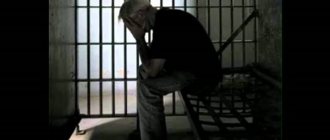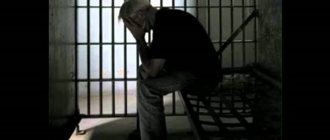What horrors did the last criminal executed in Russia, the maniac Sergei Golovkin, commit, Express Gazeta tells
Subscribe and read Express Newspaper in:
In May 1996, former Russian President Boris Yeltsin issued a decree “On the gradual reduction of the use of the death penalty in connection with Russia’s entry into the Council of Europe.” In a short time, hundreds of death row inmates’ requests for clemency were reviewed and granted. But not all of them: the most brutal murderers and criminals were denied life – among them was the maniac Sergei Golovkin, nicknamed “Fisher” or “Boa Constrictor.” He also became the last person executed in Russia* - the sentence was carried out on August 2, 1996. For what atrocities was Golovkin sentenced to death?
Moratorium on the death penalty
The last death sentence in Russia was carried out just a couple of weeks before it was abolished. To become familiar with this topic, you must refer to the Constitution of the Russian Federation and the Criminal Code. The death penalty is the highest degree of punishment that was imposed on persons who committed terrible crimes or attempted murder.
At the moment, the death penalty is prohibited by the following document: protocol number 6 and PACE recommendations. This type of punishment is legally prohibited.
Reasons for abandoning the death penalty
This type of punishment is not available for two reasons:
- signed protocol No. 6 (European Convention for the Protection of Human Rights);
- presidential decree not allowing the death penalty.
Regarding the first point, the text states that it is impossible to take the life of a person intentionally, with the exception of imposing a death sentence. That is, by and large, the European Convention allows the death penalty. But, due to a presidential decree, it remains unavailable. This document prohibits the death penalty until a jury trial is created in all regions of the Russian Federation. The last death sentence in Russia was imposed shortly before the introduction of the moratorium (April 1997), which expired in January 2010. But in 2009 it was extended until the ratification of the protocol on the abolition of this punishment.
How the non-human was detained
The disappearance of the three boys shocked local residents. Law enforcement agencies did not sit idly by - the “ring” around the maniac was already shrinking. The best operatives and investigators who had previously worked on the Chikatilo .
The corpses of Fischer’s last three victims were found by mushroom pickers on October 5, 1992. The operatives interviewed the boys’ classmates, and one of them said that on September 14, 1992, he and the three victims were driven from the Zhavoronki station by a man working at a stud farm. On the way, he suggested to the boys to “rob the kiosk.”
On the appointed day, the fourth boy could not come to the meeting, which saved his life.
Sergei Golovkin was under 24-hour surveillance, but investigators did not have any evidence to detain him. He behaved completely calmly.
But on October 19, 1992, they decided to detain Golovkin in accordance with Art. 90 of the Code of Criminal Procedure of the RSFSR, that is, before charges are brought.
During interrogation, Golovkin denied everything, and investigators were ready to let him go. However, the officer on duty, in violation of the order, left the suspect in solitary confinement overnight. In the morning, Golovkin asked to be taken to the investigator and confessed to the latest triple murder.
On October 21, 1992, Fischer's garage was searched. In the cellar they found the things and clothes of the dead, traces of blood, as well as a bathtub in which the maniac dismembered the bodies.
Article on the topic
The killer nicknamed "Mosgaz". The real story of a Soviet maniac
Review of the type of punishment after the lifting of the moratorium
The last death sentence in Russia was carried out in 1996. But what happens if the moratorium is lifted? Prisoners are not required, but have the right, to file a petition for clemency. This is completely independent of whether this document was submitted before the moratorium was introduced or not.
The death sentence can be carried out in three cases:
- after the court verdict comes into force;
- rejection of the application by the President of the Russian Federation;
- non-application of pardon if the convicted person does not apply.
It is also necessary to know that new laws can either soften or worsen a prisoner’s sentence.
The last death penalty in Russia
The last death sentence in Russia (September 2, 1996) was handed down and carried out in Butyrka to Sergei Golovkin. This citizen committed about 40 particularly serious crimes (rape and murder of boys in the Moscow region). He carried on his criminal activities for 6 years. Two days before the capture of “Boa”, the Rostov court pronounced a verdict on the most terrible and dangerous criminal of the USSR, Andrei Chikatilo.
Since similar crimes were carried out in two regions at once (Moscow and the Rostov region), employees of the USSR criminal investigation department were inclined to this version: the crimes were committed by one person who made flights between these two regions. Before the capture of "Boa", the criminal was known under the nickname "Fisher".
A nightmare for prisoners
Having found out that there was no direct evidence against him, Golovkin calmed down and began to deny any involvement in a series of crimes. The detectives tried to split it for about seven hours straight - but they never achieved their goal. Fischer was about to be released, but then the head of the criminal investigation department of the Moscow Region Central Internal Affairs Directorate, Nikolai Chekmazov, intervened in the matter. He gave orders to detain the suspect until the morning and then continue the interrogation.
Golovkin did not expect such a turn - and began to suspect that the investigation had managed to find some evidence against him: at night in his cell he made an unsuccessful suicide attempt. Meanwhile, detectives managed to obtain a search warrant for Fischer's garage. When the police went down to the basement, it immediately became clear to them: they no longer needed any confession from Golovkin. The entire room was covered in blood - traces of it were left on the walls, hooks, knives, an ax and a school uniform torn to pieces. And in the galvanized trough lay burnt pieces of human skin, also covered in dried blood...
Having learned about the results of the search, Fischer stopped denying it and began to cooperate with the investigation. Without any remorse, he pointed to the burial places of the murdered teenagers and calmly spoke about his atrocities. At the same time, Golovkin accompanied his terrible stories with obscene jokes and was daring to the detectives. One day, an investigator asked a maniac to tell him what exactly he did with his victims. “Bring your son and I’ll show you,” Fisher replied with a grin. He also explained why he did not start his own family: “I was afraid that I would do the same thing to my own son as I did to those boys.”
During the investigation, Golovkin was placed in the capital’s “Matrosskaya Tishina” pre-trial detention center: he shared a cell with two other prisoners. When they found out what their cellmate was accused of, they began to sleep in turns: they were afraid that Fischer would kill them in their sleep. His strange behavior frightened the prisoners: after hearing the joke, the maniac laughed for half an hour until his eyes turned red. As a result, they decided to place Golovkin in solitary confinement.
The result of the investigation was the fully proven 11 murders of teenagers aged 12 to 16 years, which Golovkin committed from 1986 to 1992. The details of his crimes barely fit into the 95 volumes of the criminal case. Investigators reasonably believed that Golovkin could have many more victims: during the period when the maniac was operating, about 40 teenagers disappeared in the Odintsovo district of the Moscow region. But Fischer suddenly stopped talking and did not confess to other episodes. He understood perfectly well that 11 murders would be more than enough to impose capital punishment on him. In addition, specialists from the Serbsky Institute recognized the maniac as quite sane, although they found signs of schizoid psychopathy in him.
Role-playing game
The last death sentence in Russia was handed down on September 2, 1996, to the particularly dangerous serial killer and rapist Sergei Golovkin. The most terrible thing about these crimes was that Boa constricted himself as a fascist and his victim as a partisan. For Golovkin, murder and torture are a kind of role-playing game.
He committed his first crime in 1982 near the Romantic camp. Golovkin tracked down the boy and, under threat of death, took him into the forest. There he tore off the child's clothes and hung him from a tree using a rope loop. Fortunately, this time the victim remained alive and was able to describe the appearance of the criminal.
“I said that now I will kill them”
Fischer committed his next crime 12 months later, in August 1991. His victim was a 15-year-old resident of the state farm Nevolin, who was visiting relatives in the village of Gorki-10. The teenager met a maniac when he was trying to hitch a ride, and succumbed to the persuasion of his new acquaintance to rob the dacha - but instead of a criminal adventure, the young man faced death. Fischer raped the victim, strangled, skinned and dismembered the body. The killer tried to tan the skin with salt, and took the remains to his secret cemetery outside the Moscow Ring Road.
After that, Fischer lay low and committed his next crime in April 1992. The 16-year-old boy who got into the Zhiguli with the maniac did not outwardly fit the type of Golovkin’s victims - and at first the driver was not even going to take him to his garage. But the young man made a fatal mistake: threatening Fischer with a knife, he tried to steal his car. But he easily disarmed his young opponent and unexpectedly proposed a peace settlement, which had to be secured by a joint robbery.
The teenager agreed - and soon begged for mercy in the killer's garage. But these pleas only angered Fischer more than usual. The maniac raped the teenager and subjected him to terrible torture: he hung him on hooks, burned his face with a blowtorch, put a rubber glove on his face and watched as the victim suffocated. Afterwards, Golovkin hanged the victim, gouged out his eyes, cut off his head and cut off his limbs. The victim became Fischer's eighth victim.
Sergei Golovkin
Photo: Serial-killers.ru
The maniac committed his last and most brutal massacre in September 1992, when he managed to lure three teenagers into his garage at once. They met Golovkin at Zhavoronki station and agreed to help their new friend steal cigarettes from a warehouse. Having hidden two schoolchildren in the trunk, and the third on the floor of his Zhiguli, Fischer brought them to the garage. When the teenagers went down to the basement, the maniac told the victims, numb with horror, that he would now kill them.
“Have you heard this about Fischer? This is me!” I also told them that they were my eleventh, that now I would kill them - and in what order,” Golovkin said during the investigation.
Fischer tortured and raped each of the victims in front of his comrades. And then he put a noose around the teenager’s neck and forced his friends to knock the stool out from under his feet. The most terrible fate was in store for the latter: in front of his eyes, Golovkin dismembered one of his friends, taking turns taking out and demonstrating the internal organs. And then Fischer took on the latter. He burned the teenager with a blowtorch, hung him up and raped him... Using a hot wire, the maniac burned a swear word on the boy’s body and then hanged him. Fischer gouged out the eyes of the dead victims, removed the skin from the bodies and cut off the muscle tissue. The killer removed the chain on which the icon hung from one of the dead. The maniac threw it away and kept the chain for himself.
Golovkin buried the remains of the dead in the forest, not far from the Chastsovskaya platform - approximately in the area where he killed the pioneer from the Zvezdny camp. But this time he made a mistake. The fact is that at the time of meeting the teenagers at the Zhavoronki station, there were not three, but four schoolchildren in the company. But one refused to “go to work,” which saved him from a terrible death. And the investigation into the Fischer case finally had its most important witness.
Witness
Boa Constrictor, who received the last death sentence in Russia, committed the following crimes with greater cruelty. The second victim is a teenager from the Zvezdny camp in the Odintsovo district. He cut off the boy's head and ripped open the abdominal cavity; the severed genitals were found next to the body in a bag.
The third victim was dismembered in the village of Zarechye. The crime was committed with great cruelty, because more than 30 stab wounds were found on the remains of the dismembered body.
After three cases, the Odintsovo district police department created an investigative and operational group to capture Golovkin, because it became clear that a serial, especially dangerous criminal had appeared in the city. That’s how they found the first witness in the pioneer camp “Zvezdny”, he claimed that he saw a Boa constrictor, and he said his last name.
Graying victims
Already after the first murder committed by Sergei Golovkin in the Dmitrovsky district of the Moscow region, investigators managed to draw up a verbal portrait of the maniac. This was helped by local residents who saw a strange, lanky and stooped brunette with acne scars on his face. True, every time he met random passers-by, the mysterious man tried to turn away - and no one was able to get a good look at him. Therefore, Fischer’s first sketch turned out to bear little resemblance to a maniac and was of no use to the investigation.
At the same time, detectives linked the massacres of teenagers in the Moscow region into a series only in 1986: by that time it became clear that the crimes were the work of a serial killer. Then an investigation group was urgently created, which included the best investigators from the Odintsovo region: a large-scale operation called “Boa Constrictor” began (which, by the way, became Golovkin’s second nickname). The operatives checked about 50 thousand previously convicted and mentally ill suspects - but the killer was not among them. True, along the way, the investigation uncovered more than two thousand crimes that were not related to Fischer’s case.
At some point, they tried to attribute Golovkin’s crimes to the most famous maniac of the USSR, Andrei Chikatilo: the killers were operating at the same time. But, having studied the character and type of Chikatilo’s victims, investigators quickly came to the conclusion that the style of the crimes of the two maniacs was different. Considering the history of another Soviet serial killer, honored teacher from Nevinnomyssk Anatoly Slivko, operatives began to check teachers, club leaders and coaches. But Fischer was not among them.
Image: Serial-killers.ru
Meanwhile, mutilated children’s bodies continued to be found in the Odintsovo district. Fragments of dismembered bodies were sometimes dug up by animals and dragged around the surrounding area, so it took investigators a lot of time to find all the remains. What especially struck the operatives was that the hair on the heads of some of the victims was completely gray - a reflection of the hell in which the schoolchildren visited in their last hours of life.
Investigators have suggested that the maniac they are hunting for is a resident of the Odintsovo district: a newcomer would hardly commit all the crimes in the same area. An important fact also spoke in favor of this version: when in August 1991 Fischer kidnapped a young resident of the Nevolin state farm, a state of emergency had already been introduced in the Odintsovo district. A visiting criminal would hardly be able to act in such an environment so brazenly and unnoticed by the operatives: they had to look for a local resident.
The detectives also guessed that the maniac had a car in which he took out the bodies of the dead. In addition, the suspect was most likely related to livestock farming: at one of the places where the dismembered remains of Fisher’s next victim were found, a piece of skin was found in feed salt. The way Golovkin skillfully dismembered the bodies told detectives that the suspect clearly had extensive knowledge of anatomy. This means that he could either work in a slaughterhouse or have a medical or veterinary education.
Fisher version
The last death sentence in Russia was carried out in 1996, the defendant's name was Sergei Golovkin. After committing three crimes, he “lay low” for several years. But this break was only the “calm before the storm.”
We have already mentioned that a witness was found in the Zvezdny camp. So, this boy, unlike his friend, was able to escape from the criminal. He said that they talked to him not far from the camp. Golovkin said that his last name is Fischer, he escaped from prison and the police are looking for him. The boy described his appearance and the tattoo he saw on his arm.
Thus, police officers were able to identify about 6 thousand people prone to violence and solve some crimes. But Golovkin remained free.
Childhood of a maniac
Sergei Golovkin was born in 1959, into a dysfunctional Moscow family. The father is an alcoholic who, according to some reports, molested his own child. Information about the mother is vague: some sources present the woman as quiet and downtrodden, others partly blame her for the broken psyche of a cruel maniac: they say that Golovkina often raised her voice at her son and beat him.
Sergei grew up as a physically weak boy: born with a chest deformation, he often caught colds and was sick, and also suffered from enuresis. Classmates - including the leader of the rock group "Crematorium" Armen Grigoryan - remembered Golovkin as a reserved, unremarkable guy: he studied with "B" and "F" grades, studied in sections, but without much success, and preferred solitude. By the end of school he had grown and become stronger, but he was still not interested in girls. The indifference to the opposite sex was mutual: the young man’s appearance was spoiled by acne and stooped posture.
Golovkin showed sadistic tendencies even as a child: at 13, he tortured a cat and mocked fish by lowering a boiler into an aquarium. And after the incident at the university, the tendencies of a maniac were completely formed in Sergei. The following happened: a group of teenage hooligans attacked him, a senior student at the Timiryazev Academy, and severely beat him. Later, the already detained killer admitted: thinking about revenge, he more than once excitedly imagined thin, dark-haired boys no older than 15 years old - these were his future unfortunate victims.
Maniac Sergei Golovkin. Still from the Crime TV video
Handwriting
The last time a death sentence was carried out in Russia was a few weeks before the abolition of the death penalty on the territory of the state.
During the “lull”, Fischer purchased a car and received a place for a garage on the territory of the Moscow stud farm, where he worked as a livestock specialist. Beneath it he set up a place of torture for his future victims.
This is how the criminal’s style changed, he lured people into his garage under various pretexts or picked up teenagers voting on the road. After the torture, Golovkin took the bodies to the “burial grounds.”
Real horror
Even the most ardent supporters of the humanization of legislation and the abolition of the death penalty look away when it comes to Golovkin. The atrocities of this criminal are amazing.
In the second half of the 1980s, children in Moscow and the Moscow region were frightened by a terrible killer named Fisher. The teenagers giggled and sang songs about “Uncle Fisher” - he seemed like just a character from children’s horror stories about the “Black Hand” and the “coffin on wheels.” But those who actually fell into the hands of Golovkin, before their death, experienced something that is not described even in the most chilling horror films.
The nickname “Fisher” appeared by chance, due to the rich imagination of one of the boys who was interrogated by investigators. The boy told how he met a man who introduced himself as Fischer and had a tattoo on his right hand in the form of a dagger entwined with a snake and the inscription “Fisher.”
Based on these testimonies, the police searched for the criminal until it turned out that the teenager had not actually met anyone, but had made up the story about his uncle. But rumors about "Fisher" leaked and reached the real culprit. Golovkin liked the nickname, and then he introduced himself to his unfortunate victims.
Is it impossible to “figure out” a maniac? Expert on violent people
More details
Strengthening the task force
The last death sentence in Russia was carried out on September 2, 1996. But how was the criminal caught? After strengthening the task force, another terrible crime occurred. On September 15, 1992, three boys disappeared at once.
The operatives managed to find out that Uncle Seryozha, who works at the Moscow Stud Farm No. 1, once gave them a lift in his new car. Then the employees had no doubts. We need to catch the criminal, and urgently, before other children die in the “clutches” of a serial killer.
Boa Constrictor Detention
How to make an arrest if there is no evidence? Even round-the-clock monitoring of the maniac did not produce any results.
I had to take it under Article 90 (10/19/92). Only after inspecting the garage was he charged under Art. 102 (October 30 of the same year). Golovkin indicated all the burial places; some of the people were still listed as “missing” at that time. Golovkin admitted to killing only eleven children, which did not prevent him from being sentenced to the highest degree of punishment. The investigation continued until 1994, but it was not possible to prove the involvement of Boa in other crimes.
Looking for a "hospital"
During Operation Boa Constrictor, detectives carried out a large-scale check of persons who fit the parameters of the alleged criminal and were registered in the Odintsovo region - in Golitsyno, Zvenigorod, Gorki and Perkhushkovo.
Fischer actually lived in this area, in the office building of a stud farm. But his registration was in Moscow - and he found himself outside the purview of the investigation. Then the detectives began to think about the place where the maniac dealt with the teenagers. This is how Yevgeny Bakin, senior investigator for particularly important cases under the Prosecutor General of Russia, spoke about it:
“During the inspection of the scene, a clump of hair was removed from the burial of the remains of a teenager named Nikita. An expert investigation determined that they did not belong to the victim. It was (...) the hair of another teenager killed a year ago. This circumstance indicated that the criminal dealt with the victims in one place - a “hospital.”
Murder weapons used by Sergei Golovkin
Photo: Serial-killers.ru
The detectives could have been looking for this “hospital” for a long time, and Fischer would have killed further. But then luck finally smiled on the investigation - they got a valuable witness, the same schoolboy from Zhavoronki station. The teenager immediately remembered how, together with his comrades, he met a certain man, a livestock specialist from a stable named Sergei, a leader in production, awarded a silver medal from the USSR Exhibition of Economic Achievements in 1989. Fischer himself told future victims about all this.
Golovkin was quickly identified, but was not detained: the bodies of the last three victims of the maniac had not been found by that time, which means there was nothing really to present to the suspect. However, investigators did establish external surveillance of the facility. In early October 1992, the grave where Fischer buried the remains of three victims was finally discovered: they decided to take Golovkin. And at that moment, when the maniac in his Zhiguli was driving around the Odintsovo district in search of another victim, his car was rammed by a police car. But Golovkin was not going to just give up: he tried to break away from the operatives and escape - however, to no avail. Fischer was taken to the police station and interrogated.
Puff
The last death sentence in Russia regarding Golovkin was carried out in 1996, and the court's decision was heard back in 1994. Why was the sentence not carried out earlier?
Boris Yeltsin ignored the petitions for a long time, but on the eve of the signing of Protocol No. 6, all complaints (more than 100) were urgently considered. More than half were rejected, and Golovkin’s petition was also included here. For the rest, the death penalty was replaced with life or 25-year imprisonment.









